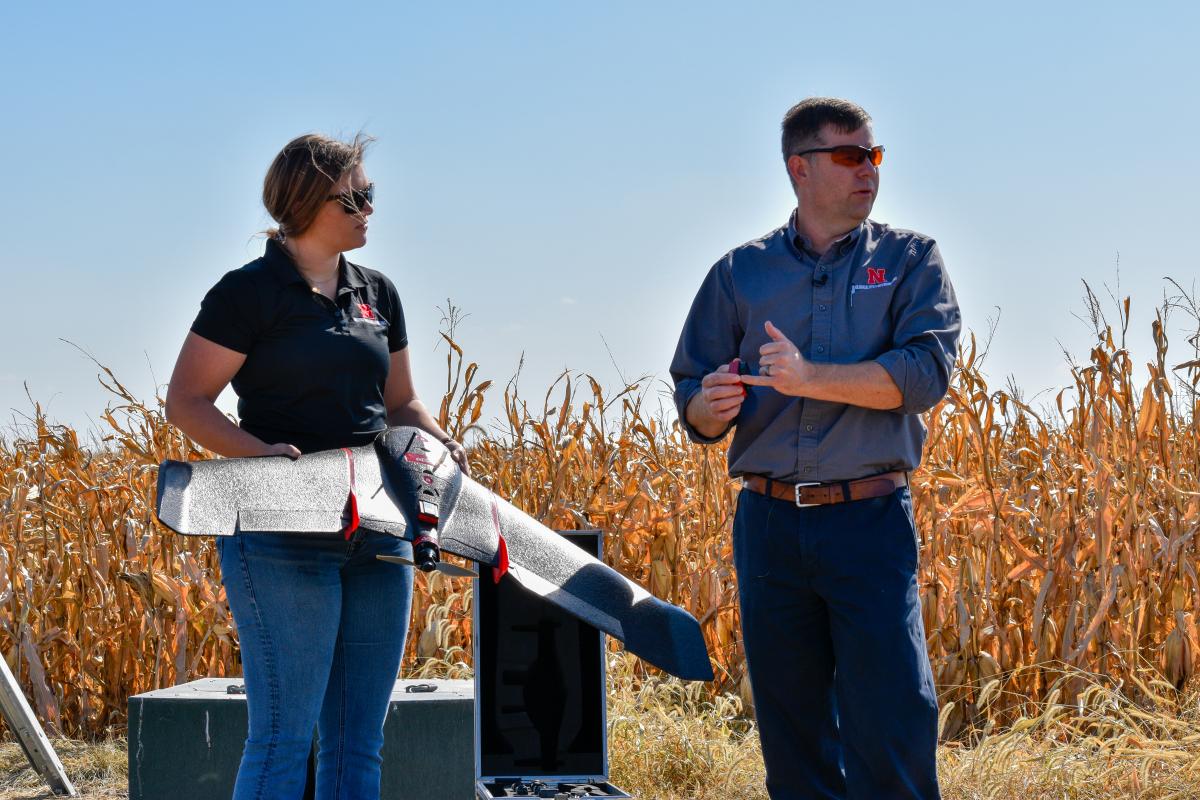
Improving Nitrogen Management
Precision Agriculture Technology Improves Nebraska Agriculture
Nitrogen is an essential nutrient for plant growth. But when nitrogen is applied at a fixed rate, whether a crop needs it or not, it can result in water pollution and unnecessary costs for farmers due to over-application. Precision agriculture is addressing this issue with sensor technology.
Joe Luck, associate professor in the Department of Biological Systems and Engineering, and Taro Mieno, associate professor in the Department of Agricultural Economics both at the University of Nebraska-Lincoln are bringing precision agriculture sensor technology to farmers across eastern Nebraska to improve nitrogen management practices in their row crop operations.
“The majority of decisions Nebraska farmers must make each year are focused on irrigation management, nitrogen application, and pest control issues,” Luck said.
Angela and Kerry Knuth of Mead, Nebraska are third-generation farmers who tested precision agriculture’s sensor technology in 2018 to improve the nitrogen management practices they use on their farm.
“Sustainable management of resources, like nitrogen, is of utmost importance to the future of our farm,” Knuth said.
Luck and his team at the Eastern Nebraska Research, Extension, and Education Center (ENREC) worked with over 80 growers to gauge nitrogen requirement variability within and between different fields across central and eastern Nebraska to develop the most sustainable nitrogen application methods.
Sensor Technology
The goal of sensor technology is to increase the efficiency of nitrogen use as fertilizer while reducing nitrate loss to groundwater.
“Identifying the specific amount of nitrogen needed within a field using sensor technology not only reduces over application of nitrogen, but also decreases pollution,” Mieno said.
Sensor application allows growers to apply nitrogen based on the specific needs of each plant.
“Sensors are located on the sprayer to essentially read the plant and detect whether it is nitrogen deficient, and if so, the amount of nitrogen needed is applied,” Luck said.
Luck’s team also uses drone sensors to take an aerial scan of the field. This scan maps the field and shows where it may be nitrogen deficient and then estimates the nitrogen requirement of the field.
In addition, Mieno observes data points from sensor technology in relation to nitrogen application, specifically, the yield data which provides up 20,000 data points in a single field.
Comparing Cost
For a management practice to be effective, it must be both economically and environmentally sustainable.
“Optimal site-specific nitrogen application is not just contributing to profitable production, but also to minimizing the environmental impact of agricultural production,” Mieno said.
The chances of a grower adopting a new practice such as sensor application weighs heavily on whether implementing it can be done without burdening the operation with added costs.
“When explaining this process to growers, most ask about success rate of using sensor technology, but all need to know how much it will cost to implement a new practice,” Luck said.
To show cost comparisons, Luck compares sensor application cost and irrigated corn yields to the grower’s current nitrogen practices. According to this data, Luck said that 54 out of 62 sites managed nitrogen more efficiently with sensor application.
As an example, the Knuth’s traditionally applied 40-50 pounds of nitrogen up front and then returned with a Y- drop sprayer application through the growing season. The sensor application reduced the amount of nitrogen they were using in the field they strip tested.
Future of Sensor Technology
The future of sensor technology is tracking real time data, taking a full circle look at agricultural production, as well as expanding geographically.
Luck hopes that sensor systems can be developed to detect the nitrogen and moisture profile of their fields in real-time.
“One thing about nitrogen is once it is on the field, it is not seen,” Luck said.
By creating a real-time visualization system, growers can see how crops change in response to elements like rain, drought, and other stressors over the growing season.
This increases growers’ knowledge and accuracy of nitrogen management in response to different variables, making the use of the resource in fields more sustainable, he said.
Luck’s team aims to connect the dots between nitrogen management in crop production to livestock production systems for a full circle look at how resource management impacts all areas of production.
“Nebraska agriculture is a circular economy,” Luck said. “It includes livestock production, pastureland management, grain production, and the fuel it takes to haul it to them.”
Second, Mieno has recently partnered with precision agriculture engineers to gain a broader perspective on nitrogen management. His goal is expanding sensor technology databases to observe yield, weather, nitrogen rate within the field, and electric conductivity to optimize site-specific applications to more crop types.
He will also continue to expand geographically, running randomized nitrogen experiments on fields across Nebraska, Illinois, Ohio, Montana, and parts of South America.
“Agriculture is global and is critical for global food security,” Mieno said. “Branching out geographically was an obvious next step.”
Ultimately, the future of sensor technology is to minimize nitrate waste, while maintaining high-level yield to feed a growing population.
For more information on research projects conducted by ENREC, please visit: https://extension.unl.edu/statewide/enre/enrec/
Key Takeaways:
- Precision agriculture, such as sensor technology, helps with nitrogen management.
- Research teams at the Eastern Nebraska Research, Extension, and Education Center (ENREEC) have worked with over 80 growers to gauge nitrogen requirement variability within and between different fields across eastern Nebraska to develop the most sustainable nitrogen application methods.
- Precision agriculture’s sprayer sensor technology allows growers to use a responsive approach to applying nitrogen to fields.
- The ultimate goal of this research is to minimize nitrate waste, while maintaining high-level yield production to feed a growing population.
- For more information on research projects conducted by ENREEC, please visit: https://extension.unl.edu/statewide/enre/enrec/
